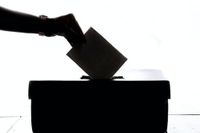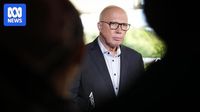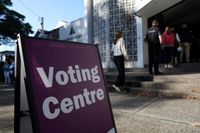As Australia approaches its federal election on May 3, 2025, recent polling indicates that Prime Minister Anthony Albanese's Labor Party is on track to secure a decisive victory, potentially marking the Coalition's worst electoral performance in nearly eight decades. According to YouGov's final MRP model, Labor is projected to win 84 seats in the 150-seat House of Representatives, while the Coalition could see its seat count plummet to just 47, a significant drop from previous elections.
Paul Smith, Director of Public Data at YouGov, noted, “Labor is poised to win an increased majority. This is a dramatic campaign turnaround considering our data in February pointed to a likely Coalition government.” This shift in momentum underscores the changing political landscape as voters prepare to cast their ballots.
The latest YouGov survey, conducted between April 1 and April 29, reveals that Labor is favored to win 52.9% of the two-party preferred vote, compared to the Coalition's 47.1%. This represents a swing of 0.7% towards Labor from the previous 2022 election, where the Coalition recorded a higher share of the vote at the campaign's outset.
In February, YouGov's projections indicated only a 1% chance of a Labor government, but as of late April, that likelihood has surged to over 97%. This remarkable turnaround is attributed to a shift in voter sentiment, particularly among younger demographics, with Millennials and Generation Z playing a crucial role in Labor's resurgence. A recent RedBridge-Accent poll also supports this trend, showing Labor leading 53% to 47% against the Coalition.
As the election nears, the Coalition faces significant challenges, with several prominent members projected to lose their seats. Liberal MPs David Coleman, Michael Sukkar, and Dan Tehan are among those expected to be ousted, as independents and Labor candidates gain ground in key electorates.
In Tasmania, where three seats are under scrutiny, Labor's Rebecca White is vying to maintain a tight hold on Lyons, while Jess Teesdale is challenging renegade Liberal MP Bridget Archer in Bass. The seat of Braddon, currently held by retiring Liberal MP Gavin Pearce, is also a focal point, with Labor hoping to capitalize on changing voter dynamics.
Albanese, while optimistic, remains cautious. He has been vocal about not becoming complacent, stating, “I have no expectations. After 2019, where people got a shock on the night, it’s really important to not get ahead of ourselves on the basis of polling.” His emphasis on hard work and grassroots campaigning reflects a strategic approach to securing votes.
In contrast, Opposition Leader Peter Dutton has hinted at the Coalition's struggles, acknowledging the weak performance of his campaign. As the Coalition prepares to release its budget costings, Dutton is focusing on emphasizing economic credentials in a bid to regain voter confidence.
The polling landscape suggests that both major parties are set to receive lower primary votes than in the last election, with Labor projected to garner 31.4% and the Coalition 31.1%. This decline in traditional support has opened the door for independents and minor parties, further complicating the electoral calculus.
One notable aspect of the election is the increasing influence of independent candidates. All sitting independents are expected to retain their seats, with challengers poised to capture several Coalition strongholds. The YouGov model indicates that independent candidates could win in electorates such as Calare, Cowper, and Wannon, further fragmenting the political landscape.
The Greens, while maintaining a steady support level of just over 12%, face the possibility of losing their seat in Brisbane to Labor, which could reduce their representation in the House of Representatives. As the election approaches, the dynamics of three-cornered contests between Labor, the Coalition, and the Greens in key electorates will be critical in determining the final outcome.
As early voting has already begun, with nearly 5 million votes cast, the atmosphere is charged with anticipation. The stakes are high, and the results of the upcoming election could reshape the political landscape for years to come.
In the lead-up to the election, Albanese has also addressed broader concerns regarding the economy and international relations. With 48% of Australian voters citing uncertainties surrounding U.S. President Donald Trump’s policies as a top concern, the Prime Minister has focused on presenting a stable and progressive vision for Australia.
Amidst the political turmoil, the Coalition has faced scrutiny over its proposed cuts to the public service, with Dutton committing to reversing 41,000 positions. This policy has drawn criticism from various quarters, including from within the party, as doubts arise over its feasibility without compromising essential services.
In the realm of education, the Greens have expressed skepticism regarding the Coalition's recent backtracking on proposed reforms to the school curriculum, suggesting that Dutton’s party is aware of the public's rejection of its more extreme policies.
As the clock ticks down to election day, both major parties are acutely aware of the shifting sands beneath their feet. With voter sentiment fluctuating and a significant number of seats in play, the 2025 federal election promises to be a pivotal moment in Australian politics.
As we await the results, one thing remains clear: the political landscape is evolving, and the voices of the electorate are louder than ever.







